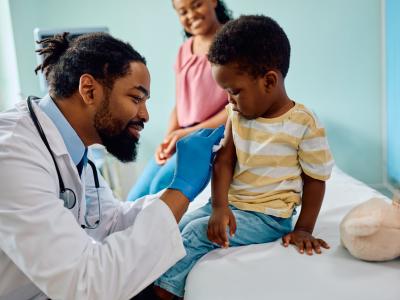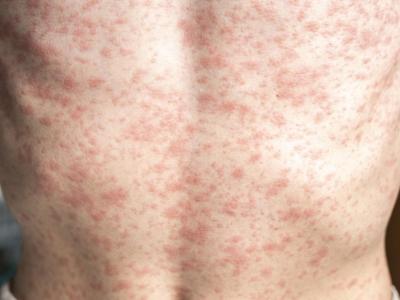Dengue candidate vaccine shows promise in phase 3 trial
Phase 3 clinical trial results for the most advanced dengue vaccine in development, known as CYD-TDV and made by Sanofi Pasteur, showed it is more than 50% protective overall and nearly 90% effective against the most serious, hemorrhagic form of the disease, according to a new study published in The Lancet.
The authors randomly assigned the study population of 10,275 healthy children 2 to 14 years of age in Indonesia, Malaysia, the Philippines, Thailand, and Vietnam to receive three injections of CYD-TDV or placebo 6 months apart. The vaccine group comprised 6,851 children and the controls 3,424; the children were followed for 2 years.
A total of 250 dengue cases were identified more than 28 days after the final injection, 117 in the vaccine recipients and 133 in the controls, for an overall efficacy rate of 56.5%. Efficacy against dengue hemorrhagic fever was 88.5%, and against dengue-related hospitalization it was 67%.
The vaccine was general well tolerated, and serious adverse events were consistent with medical disorders in this age-group, mainly infections and injuries, said the authors.
Of note was that the efficacy rates for the vaccine were nearly as high after one or two doses as after three, which could have important implications for the design of widespread immunization programs in the future, the authors said.
Dengue is a mosquito-borne disease infecting about 390 million people worldwide, particularly in Asia and Latin America, and causing symptoms in about 96 million each year, many of them children. Four distinct viruses cause the disease, DENV 1, 2, 3, and 4; CYD-TDV was most effective against DENV 3 and 4, with a 75% protective rate; rates were 50% for DENV 1 and 35% for DENV 2.
Jul 11 Lancet abstract
Jul 10 Lancet press release
Jul 11 Sanofi Pasteur press release
Antibiotic consumption rises 36% over 10 years
Monitoring of antibiotic sales across the globe over 10 years showed a 36% increase in consumption overall, with use of even some last-resort agents increasing, found a study published yesterday in The Lancet Infectious Diseases. The findings both help explain antibiotic resistance and pose crucial challenges in terms of reining it in, according the study's authors.
An international team of investigators studied sales data from retail and hospital pharmacies in 71 countries from 2000 to 2010. Over the decade, consumption rose from nearly 55 to nearly 74 billion standard units, a 36% increase. Five countries—Brazil, Russia, India, China, and South Africa—accounted for 76% of the increase.
Consumption of antibiotics varied significantly with the season in most countries. Use of two last-resort classes of antibiotics—the carbapenems and the polymixins—increased 45% and 13%, respectively.
The authors say that coordinated international programs to promote rational use of antibiotics, particularly in low- and middle-income countries, should be a priority to preserve antibiotic efficacy worldwide.
Jul 10 Lancet Infect Dis abstract
Study: Modified mosquitoes may actually enhance WNV transmission
While infecting mosquitoes with disease-resistant bacteria shows promise for interrupting transmission of dengue and possibly of malaria, the opposite appears to be true for West Nile virus (WNV), in that the manipulation appears to render the insects more prone to WNV rather than less, researchers from Penn State University and elsewhere noted in a study published yesterday in PLoS Neglected Tropical Diseases.
The authors injected adult female Culex tarsalis mosquitoes, an important vector for WNV in humans, with Wolbachia bacteria, which researchers have shown increases mosquitoes' resistance to dengue and malaria, thus blocking transmission to humans. The bacteria were allowed to replicate in the mosquitoes for 7 days. At that time they were found not only to not have become resistant to WNV but to have become infected at a faster pace than the controls.
In efforts to control the spread of dengue fever, Wolbachia-infected mosquitoes have been released into the wild, and similar strategies are under consideration for controlling malaria. The authors say their findings suggest that "field deployment of Wolbachia-infected mosquitoes should proceed with caution."
They note that their experiment involved mosquitoes transiently infected with Wolbachia in the somatic tissues rather than infected through the stable maternal route, saying further study is needed.
Jul 10 PLoS Negl Trop Dis study
Jul 10 Penn State press release
Study suggests polio shot after oral vaccine may boost immunity
Children under 5 years of age in India given an injected dose of inactivated polio vaccine (IPV) had a substantial boost in immune response, raising the possibility of adding this old tool to the polio immunization arsenal, according to a study today in The Lancet.
Indian and UK researchers last year enrolled 450 children 1 to 4 years old in the study, all of whom had their last dose of oral polio vaccine (OPV) 6 months or more before the study. Half of the participants received IPV, while the rest received no vaccine. They collected stool samples 7 days after a challenge dose of serotype 1 and 3 bivalent OPV to assess intestinal mucosal immune response.
In the IPV group, 27 of 224 children assessed (12%) shed serotype 1 poliovirus and 17 (8%) shed serotype 3 poliovirus, compared with 43 of 222 (19%) and 57 of 222 (26%), respectively, in the no-vaccine group.
The authors conclude that the substantial boost in intestinal immunity from IPV indicates a potential role for the vaccine to accelerate eradication and prevent outbreaks.
Lead author Jacob John, MD, from Christian Medical College, India, said in a Lancet press release, "Adding a supplementary IPV dose to children already vaccinated with OPV may hasten polio eradication by boosting herd immunity in endemic regions, act as a booster to prevent international spread by travellers, and minimise the risk of polio outbreaks due to imported wildtype or vaccine-derived polioviruses."
Although OPV is highly effective, easy to administer, and inexpensive, its ability to generate a strong intestinal immune response wanes as early as a year after vaccination, according to the release.
An expert on preventive medicine, however, writing in an accompanying commentary, was more cautionary about the findings.
"The effects on overall population immunity and cost-effectiveness of an extra dose remain uncertain, and comparisons between extra IPV and OPV doses on population immunity must account for their differences in seroconversion, secondary spread, and cost," said Kimberly M. Thompson, ScD, of the University of Central Florida College of Medicine. She added that some studies suggest the benefit on overall population immunity might be small.
Jul 11 Lancet abstract
Jul 10 Lancet press release
Jul 11 Lancet commentary
WHO notes youth of 2013 H5N1 patients
The vast majority of H5N1 avian flu cases in 2013 were in children and younger adults, and the number of cases was up slightly from 2012, according to a report of influenza at the human-animal interface published today by the World Health Organization (WHO).
The agency confirmed 39 H5N1 cases last year, up from 32 in 2012 but well down from the 62 cases in 2011. The vast majority of 2013 cases—26—were in Cambodia, with the rest in Bangladesh, Canada (in a traveler to China), China, Egypt, Indonesia, and Vietnam. Egypt had the second-most cases, at 4.
Of the 39 cases, 22 (56%) were in children 10 years old or younger, and 36 (92%) were in people younger than 40. The median age was 6 years, compared with 18 in 2012, 13 in 2011, 25 in 2010, and 5 in 2009.
The overall case-fatality rate was 64.1% (25/39), which was slightly higher than in the previous 3 years: 62.5 % in 2012, 55% in 2011, 50% in 2010. Nineteen of 23 cases (83%) with known information involved exposure to poultry. No case clusters were reported in 2013.
The report also mentions previously noted avian flu cases involving these strains: H7N9, 158 cases; H7N7, 3; H9N2, 2; H6N1, 1; H10N8, 1 (followed by 2 in early 2014). It also includes discussion of variant H3N2 and variant H1N1 in people in the United States after swine exposure.
Jul 11 WHO report













